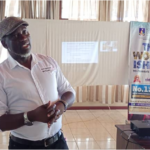Sub-Saharan Africa fails to Meets Access to Clean Water Goal Ahead of Time
Published on March 9, 2012 at 8:58 AM by FACE OF MALAWI
Though the world has reached the Millennium Development Goal of cutting by half the number of people without access to safe drinking water five years ahead of the 2015 deadline, most Africa countries are not about to.
This is according to a report by the UN children agency-UNICEF and World Health organization.
The report released ahead of the 6th World Water forum in Marseilles France indicates that 89 percent of the world’s population, or more than six billion people, now use improved drinking water sources.
Between 1990 and 2010, more than two billion people gained access to piped water supplies, protected wells and other improved drinking sources.
Children collecting water in Kabale district of Uganda
But according to the same report over 780 million people in the world are still without access to improved sources of drinking water. This group accounts for 11 percent of the global population and the largest fraction is in Sub Sahara Africa.
The report indicates that Sub-Saharan Africa and Oceania are not on track to meet the MDG drinking water target.
The heartbreaking truth is that 605 million people will be without an improved drinking water source and 2.4 billion people will lack access to improved sanitation facilities by the turn of 2015.
Over 780 million people in the world are still without access to improved sources of drinking water
Commenting on the report the United Nations secretary general Ban Ki moon commended this achievement. “This achievement is a testament to the commitment of Government leaders, public and private sector entities, communities and individuals who saw the target not as a dream, but as a vital step towards improving health and well-being” he noted. “Of course, much work remains to be done”, the secretary general cautioned adding that achieving the MDG drinking water target is a major step, but ultimately, only one step on a long journey that we have yet to finish.
The report suggests a number of ways to help areas that are far-off the target like sub-Sahara African and Oceania. “Continued efforts are needed to reduce urban-rural disparities and inequities associated with poverty; to dramatically increase coverage in countries in sub-Saharan Africa and Oceania; to promote global monitoring of drinking water quality; to bring sanitation ‘on track’; and to look beyond the MDG target towards universal coverage”, the report recommends.


